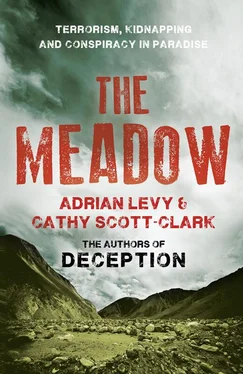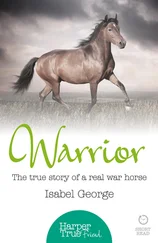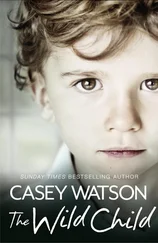A few nights before they left for New Delhi, Don took out a notepad. ‘The Don Hutchings yellow-legal-pad method of decision-making’, as friend George Neal called it. The biggest ‘pro’ was the weather. Don’s work commitments meant they could only trek at the end of June that year, and for a maximum of two weeks. That ruled out possibly safer destinations like Nepal, which would be lashed by monsoons at that time. For Jane, there was also Kashmir’s flora, which she had read was second to none: wild mountain strawberries, lilac and forget-me-nots.
The obvious ‘con’ was the unrest. What to say about that? Don made a list.
1 According to the limited information they had been able to pick up, the trouble was largely restricted to the northern and western portions of the Kashmir Valley, close to the border with Pakistan, far from where they intended to trek in the mountains rising to the east of the valley.
2 None of the violence had been aimed at foreigners.
‘We had heard consistently that as long as you stayed out of the central part of Srinagar, the summer capital, out of the old part of the city … there were typically no problems,’ Jane said. Although they would have to fly in to Srinagar, they planned to stay only as long as it took them to negotiate a taxi ride south to the hill-station town of Pahalgam sixty miles away, the starting point for many treks.
Don and Jane invited some Spokane Mountaineers over for a farewell dinner. They were leaving with open minds and a back-up plan, they told them. Mount Rainier was probably far more taxing than anything they would encounter in Kashmir, Don said, reminding them that in 1981 an ice plug had fallen from above, entombing eleven climbers traversing the Ingraham Glacier on the mountain’s eastern flank, the worst mountaineering accident in American history. And Don and Jane had erred on the side of caution once before, and regretted it. Having travelled to La Paz in Bolivia so as to climb to Machu Picchu, they had been warned away by local officials, only to discover from other climbers that the route had been safe.
‘We’re going to look into it,’ Don told his friends as he bade them goodbye. ‘We’ll ask the authorities there: the Indian government tourism bureau and the American Embassy. We’ll see what they have to say.’ He had already tried to call the Indian Consulate in San Francisco several times, but had been unable to get through. He had another worry too. Jane had recently injured her shoulder, and part of the reason they had decided to head for Pahalgam was because they had read that there they could hire ponies to carry their equipment. ‘That was the first choice, as I wouldn’t have to carry a heavy pack,’ Jane said. They promised to make some final checks upon arrival in New Delhi. ‘It only seemed logical that the Indians would know best what was safe or unsafe.’ For a seasoned traveller like Jane Schelly, asking people on the ground for advice seemed the logical thing to do.
India even confuses Indians. And in June 1995, a 48°C heatwave was cooking everything, including the roads, chewing them up, licking deep concave bowls into the tarmac, while the humidity that made the night queen blossom like nowhere else in the world also peeled the stucco off buildings. Jane had taken the sensible precaution of ringing ahead and booking a hotel with air-conditioning for the two nights they intended to stay in New Delhi.
But nothing had prepared them for the wall of opportunists waiting in the arrivals hall of the old Indira Gandhi International Airport, all of them with an idea, and an address. A traveller needed a rude strategy to deal with them, a fixed plan to stick by, a determined walk that gave not a scintilla of encouragement to the waiting crowd. Weakness was punished. Politeness was exploited. Indecision was manna for the middle man. Born-and-raised New Delhi-ites blanked strangers and brushed aside enquiries from touts. Surrounded by the throng, Jane and Don found their contingency plan failing the minute they arrived in New Delhi on 25 June 1995. The chaos bowled them over.
Weakened by ‘thirty-five hours in the air’, as Jane put it, no sooner had they collected their luggage than they were lured into a conversation with reps from a private-accommodation agency and convinced that their pre-booked hotel was a bad choice. Hustled off to a different place in another part of town, Jane and Don began their Indian journey in confusion. It happened to everyone, Don said afterwards. It was no big deal, Jane murmured. They had seen this sort of thing before.
The phone in their hotel room did not work, and the next morning Jane and Don headed out into the mêlée of New Delhi’s streets. A taxi they had not ordered was waiting to take them to a private tourism agency they did not want to do business with. ‘We knew there was another scam going on,’ recalled Jane. ‘But we said to ourselves, “OK, we’ll go and we’ll listen, but we’ll be watchful.”’ At the agency, the staff proved helpful, and seemed knowledgeable about Kashmir. They assured them it was safe. The main focus of the insurgency, as Don and Jane had already heard, was far away, concentrated in the western portion of the valley near where Pakistan began, a ceasefire line so disputed that neither side could agree to call it a ‘border’. Instead, it was known as the Line of Control (LoC).
This sounded reassuring. But they wanted a second opinion, and set off for the government tourism office. ‘They didn’t deny there were problems,’ Jane said, but the general message was the same: the insurgency was very localised. Stay out of downtown Srinagar and everything would be fine. Most importantly, the trekking areas were safe. Finally, they spent an hour trawling backpacker hangouts, searching for anyone who had just returned from Kashmir. There were plenty, and those they spoke to had all had a trouble-free time. ‘They seemed to love it, and gave glowing reports of the beauty,’ said Jane.
Even though both of them were now flagging, Don insisted on one more stop. They took a ride to leafy Chanakyapuri, New Delhi’s diplomatic enclave, to get advice at the US Embassy. ‘It was closed for lunch, and we were intimidated by the long lines of people,’ Jane said. ‘It was hot as heck – we were jetlagged, and had been told at the Indian government tourist office that the area was OK for tourists.’ They gave up, and returned to the hotel. ‘If there had been a red flag at any point, then we would have researched further,’ said Jane.
As Jane Schelly and Don Hutchings began to plot their Kashmir plan in the spring of 1995, Julie and Keith Mangan, from Teesside in the north-east of England, were packing for the trip of their lives, one that would also lead them to the Meadow. Casting their eyes around the world for somewhere to explore in the run-up to their tenth wedding anniversary, Julie and Keith, both aged thirty-three, had decided on India. This would be their first time in the subcontinent. In fact, it would be their first exotic trip together anywhere, a holiday they had long promised each other, having married at a time when they had been too broke to have the kind of dream honeymoon they had both wanted.
India, and Kashmir in particular, sounded very far from the close-knit and hard-working Teesside city of Middlesbrough, where Julie and Keith had grown up. With its flinty vistas of pipelines and cooling towers, it wasn’t pretty, but Middlesbrough people seldom left. They worked in the vast foundries and industrial plants of companies like British Steel. Among them had been Keith’s father, Charlie Mangan, a British Steel plater whose punishing working life had left him with a miserly pension and a host of chronic ailments.
Julie and Keith loved their families, and they loved the north-east. They scorned people who denied who they were, people who overwrote where they came from. But they needed a change. Keith had hankered to see the world since he was nine, an itch he had got when he had gone to Lake Garda in Italy on a school trip. His mother Mavis, a school dinner lady originally from Brambles Farm council estate in the east of the city, still had photos of him larking around at the water’s edge with Neil Jones, his best friend. It hadn’t been the greatest adventure in the world, but it had set something off in Keith, and after he married Julie he had got her thinking about travelling too.
Читать дальше











